Journalists are eligible for free email subscriptions to SEJournal, including TipSheet, WatchDog (on access issues) and more.
Concurrent Sessions
Energy Futures Plenary
Mini-Tours
Anniversary Party
| Agenda | Coverage | Lodging/ Travel | Exhibits/Receptions | Environmental News | About Norman |
As a journalism organization that believes in an open society, SEJ each year welcomes a diverse group of attendees to our annual conference. Attendees include representatives of business, government and environmental groups, as well as working journalists, academics and students.
Because non-journalists are here, you may see or hear presentations or responses to presentations that you might not expect from mainstream journalists. The presentations and any responses do not necessarily reflect the views of SEJ or any of its members.
As our guest, you should respect our interest in open discussions of environmental issues by thanking all participants in sessions you attend and not disrupting presentations of views you disagree with.
Finally, please respect our rule that SEJ members are given preference during question-and-answer sessions.
Saturday, October 10, 2015
All sessions, as well as registration, exhibits and breaks, will be at the
Embassy Suites & Conference Center, 2501 Conference Drive,
Norman, OK 73069, (405) 364-8040.
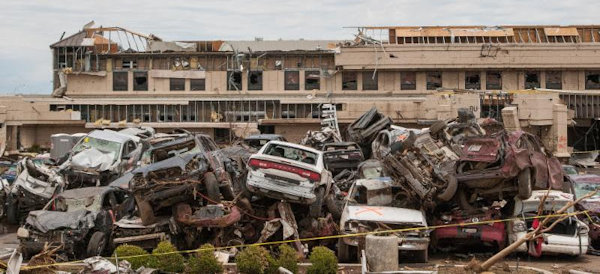 |
| Tornado damage. © Brent Fuchs / The Journal Record. |
Registration
8:00 a.m. - 2:30 p.m.
Location: In the foyer of the Embassy Suites & Conference Center, 2501 Conference Drive, Norman, OK, near the glass doors to the parking lot
If you didn't sign up ahead of time for the Saturday night party or Sunday brunch at the National Weather Center, there may still be room — please check with registration.
SEJ Information Table
8:00 a.m. - 2:30 p.m.
Location: Convention Center foyer near registration
Sign up here for Saturday mini-tours. Find information about SEJ Award winners, election results, membership and services. Pick up copies of SEJournal and other SEJ information.
SEJ Exhibits
8:00 a.m. - 2:30 p.m.
Location: Oklahoma Ballroom
Don't miss the wealth of information offered by the 2015 exhibitors. Learn about environmental issues and innovations, educational opportunities, see some great displays and add to your source list.
Breakfast with Weather Researchers and Tornado Chasers
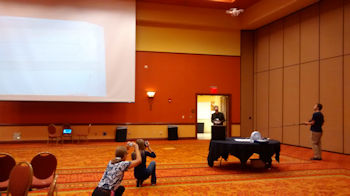 |
| UMissouri prof Bill Allen's students fly a drone in the Oklahoma Ballroom. Click to enlarge. Photo courtesy of Cindy MacDonald. |
7:00 - 8:45 a.m.
Location: Oklahoma Ballroom
The omelet bar will be back. So will our exhibitors showcasing their coolest stuff. From tornado chase cars and mobile storm radar trucks to drones and prototype alternative vehicles, we'll have all sorts of hands-on displays and eye-opening demos and newsmaking announcements.
Emcee: Amy Gahran, Reporter, EnergyBiz.com
Concurrent Sessions 3
THE CRAFT 1
Pipelines at Your Doorstep: Safety and Routing Databases
Location: University A
When a natural gas pipeline explodes or an oil pipeline spills, the results can be disastrous. Pipeline safety is a local story almost everywhere, and this session will give you the map and data resources to find it. We will also discuss the many barriers to getting information the public needs to understand potential dangers, inspection, maintenance and regulation. We will take a hands-on look at the National Pipeline Mapping System and explore safety incident data from the Pipeline and Hazardous Materials Safety Administration. Bring your laptop. Coverage.
Instructor: Joseph A. Davis, Freelance Journalist and WatchDog Project Director/TipSheet Editor, Society of Environmental Journalists
THE CRAFT 2
Hands-On Google Workshop: Building Maps and Graphics
Location: University B
Enliven your stories with graphics — without being dependent on someone else to make them. This session serves as a refresher for the Wednesday workshop, so that attendees can go home confident they understand Google's graphics tools. Additionally, if you missed Wednesday, come learn the basics of using Google's free graphics tools for journalists. You'll need a Google account and understanding of Google Drive. Bring your laptop.
Moderator: John Schmeltzer, Engleman/Livermore Professor in Community Journalism, Gaylord College of Journalism and Mass Communication, University of Oklahoma
Speaker: Joey Stipek, Online Journalist and Web Designer
ENERGY
Fracking: What’s Happening in Your Home State?
Location: University C
Drilling activity is booming in several tight shale basins across the U.S., driven by the increasing use of hydraulic fracturing and horizontal drilling. The fracking boom has created jobs, fueled government revenues and economic growth, and created domestic energy supplies for the nation. It has also raised concerns about environmental damage to ground water and air quality, as well as nuisance impacts such as light, noise and traffic. The response in some locations has been to restrict, even ban, fracking. Industry has followed with lawsuits. Join us for a discussion of what’s going on in the states. Coverage.
Moderator: Tripp Baltz, Staff Correspondent, Bloomberg BNA
Speakers:
Adam Briggle, Associate Professor, Department of Philosophy & Religion, University of North Texas and President, Denton Drilling Awareness Network
Arnella Karges, Executive Vice President, Oklahoma Oil & Gas Association
Bobby Magill, Senior Science Writer, Climate Central
Mark Truax, Director of Operations and Coalitions, Coloradans for Responsible Energy Development
NATIVE AMERICANS AND DIVERSITY
Conservation and Mineral Extraction on Native Lands
Location: Sooner B
Mining and oil and gas production can be considered an environmental bane or economic blessing regardless of the area of extraction. The issues, however, amplify on American Indian lands where minerals can be a singular source of income for tribal governments and individual tribal citizens. Added to that is a complex web of federal legislation and regulations on Indian lands, which are estimated to contain as much as 50 percent of uranium reserves and 20 percent of oil and gas reserves. On the other end of the spectrum, organizations and grassroots leaders guide conservation movements to preserve Native land bases before they are disturbed. Coverage.
Moderator: Jodi Rave Spotted Bear, Executive Director, Fort Berthold Communications Enterprise
Speakers:
Edmund Baker, Environmental Director, Mandan, Hidatsa and Arikara Nation
Leona Morgan, Co-Founder, Diné No Nukes
Terry Tatsey, Director, Institutional Development, Blackfeet Community College and Board Member, Blackfeet Tribal Natural Resource Conservation District
CLIMATE CHANGE AND WEATHER
A Most Violent Sky: On the Frontier of Severe Weather Research
Location: Sooner A
The weather can turn from clear to pouring rain and lightning in seeming minutes. Enormous strides have been made understanding severe weather, yet there remains many open questions. We’ll discuss how modeling, technology and field campaigns are working together to unveil some of the mysteries of severe weather and provide people with greater warning, especially at night when loss of life can be greatest. We'll also examine research that seeks to bridge the gap between extreme weather and climate change. How much can we pin the latest drought or flood on global warming? 'Attribution research' has begun yielding some answers. Coverage.
Moderator: Andrea Thompson, Senior Science Writer, Climate Central
Speakers:
Gregory Carbin, Warning Coordination Meteorologist, Storm Prediction Center, National Weather Service, National Oceanic and Atmospheric Administration
Renee McPherson, Co-Director, South Central Climate Science Center and Associate Professor of Geography and Environmental Sustainability, University of Oklahoma
David Parsons, Professor and Director, School of Meteorology, University of Oklahoma
4th speaker TBA
THE LAND
Are We Exhausting the Planet?
Location: Boomer B
For much of the last century, humans grabbed what seemed like infinite resources. With a growing population, access to more technology and increased urbanization, we have tripled global food and water consumption in the last 50 years and quadrupled fossil fuel consumption. So what does that mean for our land use and for how we feed ourselves? And how can new agricultural methods help us be more resilient to climate change as well as reduce emissions? What is the potential for new agricultural practices to reconcile the threat of climate change with the need to feed a growing world population? Coverage.
Moderator: Lisa Palmer, Journalist and Fellow, National Socio-Environmental Synthesis Center
Speakers:
Robert Engelman, Senior Fellow, Environment and Society Program, Worldwatch Institute
Jeffrey Hayward, Director, Climate Program, Rainforest Alliance
Holger Kray, Lead Agriculture Economist, Agriculture Global Practice, The World Bank
Meera Subramanian, Independent Journalist and Author, "A River Runs Again: India's Natural World in Crisis, from the Barren Cliffs of Rajasthan to the Farmlands of Karnataka"
FOOD AND AGRICULTURE
Ecosystem-Based Strategies for Climate Change Adaptation on U.S. Farms and Ranches
Location: Boomer A
Ecosystem-based climate change adaptation strategies take advantage of the climate protection services produced by healthy ecosystems. For example, healthy agricultural soils sequester carbon, reduce the need for irrigation, fertilizers and pesticides, and help to reduce flooding. The benefits of ecosystem-based adaptation are widely recognized by the international development community, but have received less attention in the United States where engineered strategies have dominated adaptation research and development efforts. This panel brings together representatives of the federal government, agricultural industry and educational organizations who are working to encourage the use of ecosystem-based climate risk management tools for U.S. farms and ranches. Coverage.
Related information: Tipsheet.
Moderator: Laura Lengnick, Lead Scientist, Cultivating Resilience, LLC; Lead Author, "Climate Change and U.S. Agriculture: Effects and Adaptation" (USDA 2012); and Author, "Resilient Agriculture: Cultivating Food Systems for a Changing Climate"
Speakers:
Kim Barker, Rancher and Holistic Management Practitioner and Educator
Jerry Hatfield, Plant Physiologist; Director, National Laboratory for Agriculture and the Environment (NLAE); and Regional Leader, Midwest USDA Climate Hub, NLAE, Agricultural Research Service, U.S. Department of Agriculture
Ernie Shea, President, Solutions from the Land, and Founder and Principal, Natural Resource Solutions
Coffee Break with Exhibitors
10:15 - 10:45 a.m.
Location: Oklahoma Ballroom
Concurrent Sessions 4
THE CRAFT
Show Us the Money
Location: University B
The panel will dissect how increased money in politics is influencing energy and environment policy from the oil boom to climate change. Last election, the battle came down to the Koch brothers versus Tom Steyer. How will high-powered donors and fundraising quotas influence the positions of 2016 presidential candidates on natural gas, coal, renewables, curbing greenhouse gas emissions and more? What energy and environment issues will shape battleground Senate races? And how can reporters better cover the money trail influencing local and national policies? Coverage.
Moderator: Laura Barron-Lopez, Congress Reporter, The Huffington Post
Speakers:
Edwin Bender, Executive Director, National Institute on Money in State Politics
Russ Choma, Reporter, Washington Bureau, Mother Jones
Keith Gaddie, President's Associates Presidential Professor; Chair, Department of Political Science; Associate Director, Center for Intelligence & National Security, University of Oklahoma
ENERGY
Get on the Oil Train (or Pipeline): Policies and Future
Location: University C
Pick your poison? Tough choices exist in the path of the domestic energy boom. Communities across the country face environmental challenges from unit trains carrying highly combustible crude oil; aging oil and natural gas pipelines are prone to rupture; and new pipelines are proposed to transport shale gas to market. The panel will talk about the hazards to the public and environment; the policy tradeoffs of pipelines vs. rail and natural gas vs. coal; and the market forces that make pipelines and oil trains big news in your media market. Coverage.
Moderator: Michael Martz, Staff Writer, Richmond Times-Dispatch
Speakers:
Kyle Isakower, Vice President, Regulatory and Economic Policy, American Petroleum Institute
Jessica McDiarmid, Freelance Journalist
James Osborne, Energy Reporter, The Dallas Morning News
Lorne Stockman, Research Director, Oil Change International
WATER
Trouble at the Tap: Beyond the Toledo Water Crisis
Location: Oklahoma G
Western Lake Erie algae got so thick in August of 2014 that the toxin produced by it, microcystin, breached Toledo's water-treatment system. It made tap water unsafe for nearly three days, a stunner for a metro area of nearly 500,000 people along one of the world's largest collections of fresh water. Bottled water flew off store shelves, Toledo became a temporary site for Ohio National Guard relief efforts and, later, a poster child for U.S. EPA Administrator Gina McCarthy's speeches on water quality. But Lake Erie's dominant species of algae is 3.5 billion years old — one of the oldest living things on Earth — and on the rise globally — from Europe to Africa to Asia and all across North America – because of the common problems of agricultural runoff, sewage overflows, poor land use and — oh, yeah — climate change. What happens when an algae-induced crisis strikes fear in your community? Coverage.
Related information:
- "Scientists: Algae Not Just Toledo Problem," The Blade, Sep 27, 2015, by Tom Henry.
- "Toxic Algae Struggles Leave Toledo's Reputation Hanging in the Balance," The Blade, Aug 2, 2015, by Tom Henry.
- "Just When You Thought Everyone Was Awash with Rhetoric, Some Refreshing Candor Emerges in the Toledo Water Crisis," Ripple Effect blog, Aug 17, 2014, by Tom Henry.
Moderator: Tom Henry, Environmental Writer/Columnist, The (Toledo) Blade
Speakers:
Craig Butler, Director, Ohio Environmental Protection Agency
Kelly Frey, Sanitary Engineer, Ottawa County, Ohio
Greg Kail, Director of Communications, American Water Works Association
Jeffrey Reutter, Special Advisor, Ohio Sea Grant College Program, F.T. Stone Laboratory, Center for Lake Erie Area Research and the Great Lakes Aquatic Ecosystem Research Consortium, Ohio State University
Frank Szollosi, Manager, Great Lakes Regional Outreach, National Wildlife Federation
NATIVE AMERICANS AND DIVERSITY
Indian Environmental Law: Flexing Legal Muscle Beyond Reservation Lands
Location: Sooner B
American Indian tribes are no longer acting solely as stewards and protectors of their own lands. In recent years, Native Nations and Indian activists have combined environmental law with Indian law to win protections that benefit people far beyond Indian Country boundaries. We will examine how tribes are using effective legal strategies to reduce environmental threats from industrial pollution, uranium mines and superfund sites, and will look at how tribes are invoking treaty rights to water for the protection of aquifers and surface water sources. In some cases, tribes have managed to break through legal log-jams to put environmental protections in place that are contributing to healthier communities across broad regions. If this session interests you, we recommend you first attend Friday morning's "Indians 101: The Law and the Land." Coverage.
Moderator: Vicki Monks, Freelance Writer
Speakers:
Jason Aamodt, Professor of International Environmental Law and Water Law; and Assistant Dean of Online Legal Education, College of Law, University of Tulsa
Taiawagi Helton, Attorney and Professor, College of Law, University of Oklahoma
Duane Smith, Chickasaw Nation Water Consultant and former Executive Director, Oklahoma Water Resources Board
Debra White Plume, Lakota Activist and Consulting Producer, "Crying Earth Rise Up"
CLIMATE CHANGE AND WEATHER
From D.C. to Paris: Climate Talks 101
Location: Sooner A
Two months after SEJ meets in October, hundreds of negotiators from around the world will descend on Paris to hammer out a new climate accord. This will be one of the biggest environment stories of 2015, as it's viewed as the last chance to avert global warming of significantly greater than 2 degrees Celsius (3.6 degrees Fahrenheit) above preindustrial levels. What do you need to know to write with authority? What themes in U.S. policy can we expect going forward? Hear from one of the nation's leading climate reporters on the road ahead and gain insights on international negotiations from a veteran who sits at the table and works to influence policy. Coverage.
Moderator: Tim McDonnell, Reporter, Mother Jones and Associate Producer, Climate Desk
Speaker: Jennifer Morgan, Global Director, Climate Program, World Resources Institute
THE LAND
Plight of Western Grouse: Trying To Be Wild in an Increasingly Tamed World
Location: Boomer B
The debate over species conservation has recently centered on an unassuming chubby little grouse with a famously elaborate mating dance. Residing in the southern Great Plains states, the lesser prairie chicken was listed as threatened under the Endangered Species Act in March of last year. Energy interests, development companies, federal agencies, environmental NGOs and conservation bankers have been debating the best approach to protect this species. The greater sage-grouse is also embroiled in this running argument. The grouse is not yet listed despite a 30% population decrease, but a decision is expected shortly from the U.S. Fish and Wildlife Service. Coverage.
Moderator: Gloria Gonzalez, Senior Editor, Crain Communications and former News Editor, Ecosystem Marketplace
Speakers:
Eric Holst, Senior Director, Working Lands Program, Environmental Defense Fund
Sean Kyle, Industry Services Director, Western Association of Fish and Wildlife Agencies
Mike Thabault, Assistant Regional Director for Ecological Services, U.S. Fish and Wildlife Service
Wayne Walker, Principal and Founder, Common Ground Capital
FOOD AND AGRICULTURE
Soil Tillage, Rainfall and Runoff
Location: Boomer A
Do water quality issues have you curious about agricultural runoff? This workshop uses a rain simulation test to show how water runs off fields under different tillage or land-management scenarios. If the weather is nice, we may plan on moving this workshop outdoors. Coverage.
Moderator: Chris Clayton, Agriculture Policy Editor, DTN/The Progressive Farmer
Speakers:
Shanon Phillips, Director, Water Quality Division, Oklahoma Conservation Commission
Clay Pope, Consultant, Southern Plains Climate Hub, U.S. Department of Agriculture and former Executive Director, Oklahoma Conservation Districts
Greg Scott, Soil Scientist, Carbon/Soil Health Program, Oklahoma Conservation Commission and former Oklahoma State Soil Scientist, Natural Resources Conservation Service, U.S. Department of Agriculture
Lunch and Plenary Session
Our Energy Future
Noon - 2:00 p.m.
Location: Oklahoma Ballroom
 Oklahoma is a microcosm of energy rights and energy fights across the nation. Utilities are eager to add more renewable energy, but struggle with transmission power. They’re also grappling with the EPA’s proposed Clean Power Plan, which might make coal-fired plants uneconomical. The state is home to several independent oil and gas drillers, known for pioneering horizontal drilling and hydraulic fracturing methods that have fueled the recent boom. As towns push back on the industry’s right to drill in or near city limits, states are considering preempting the municipal bans. We’ll explore Oklahoma as both a microcosm and a driver of energy use nationally with experts from all sectors. Coverage.
Oklahoma is a microcosm of energy rights and energy fights across the nation. Utilities are eager to add more renewable energy, but struggle with transmission power. They’re also grappling with the EPA’s proposed Clean Power Plan, which might make coal-fired plants uneconomical. The state is home to several independent oil and gas drillers, known for pioneering horizontal drilling and hydraulic fracturing methods that have fueled the recent boom. As towns push back on the industry’s right to drill in or near city limits, states are considering preempting the municipal bans. We’ll explore Oklahoma as both a microcosm and a driver of energy use nationally with experts from all sectors. Coverage.
Moderator: Erin Ailworth, Energy Reporter (Houston-based), The Wall Street Journal
Speakers:
Denise Bode, Attorney and Principal, Cornerstone Government Affairs
Kyle Isakower, Vice President, Regulatory and Economic Policy, American Petroleum Institute
Jim Roth, Director and Chair, Clean Energy Practice Group, Phillips Murrah Law Offices
Mini-Tour Bonanza
2:15 - 5:30 p.m.
Sign up on-site for the tour of your choice at the SEJ Information Table beginning Wednesday afternoon.
Logistics: Following the lunch session, gather in the lobby near registration. SEJ staff will direct you to the right bus. Buses will be staged for departure in the order below. Please note that tours 1 and 2 will share the first bus, and thus tour 3 is in bus 2, etc. All buses should return to the hotel no later than 5:30 p.m.
-
Kayaking the Canadian River (shares bus with tour 2)
The Canadian River was once free flowing through Oklahoma City, but severe flooding prompted city officials to transform it, essentially, into a ditch. We'll take kayaks on the river to see how a major development project beautified the stream, revitalized the metro section, opened it to water sports and rechristened its city section to The Oklahoma River. Renovation helped increase kayaking and water sport consciousness among new sectors of the population, and also had an effect on its macroinvertebrate and plant populations.Tour Leaders:
Tina Casagrand, Freelance Journalist
Kendra Pierre-Louis, Independent Journalist and Author, "Green Washed"Speakers:
Priscilla Crawford, Oklahoma Natural Areas Registry and Oklahoma Biological Survey, University of Oklahoma (invited)
Derrick Johnson, Section Head, Stormwater Runoff, Oklahoma City (invited)Attendee Cap: 25 (bring $25 cash and proper attire for kayaking)
-
Oklahoma City Bombsite (shares bus with tour 1)
The Oklahoma City National Memorial & Museum is in the Journal Record Building, which was home to The Journal Record, a daily business and legal newspaper dating back to 1903, on April 19, 1995. The building is north of the Alfred P. Murrah Federal Building. The Memorial Museum is an interactive learning experience that takes visitors on a chronological self-guided tour through the story of April 19, 1995, and the days, weeks and years that followed the bombing of Oklahoma City’s Alfred P. Murrah Federal Building. David Page has worked at The Journal Record since 1979. Today he is special projects editor. He is a member of the Oklahoma Journalism Hall of Fame. On the day of the bombing, he could see the main entrance to the federal building from his office window. He was among those injured. Page will tell about his experience on the day of the bombing and how The Journal Record was able to resume publication the next day.Tour Leaders:
David Page, Special Projects Editor, The Journal Record
Sara Sneath, Reporter, Victoria Advocate (Texas)Speaker: Mary Ann Eckstein, Media Director, Oklahoma City National Memorial & Museum
Attendee Cap: 25
-
Moore, OK: Response, Recovery and Resiliency
An EF-5 tornado ripped through Moore, OK on May 20, 2013, taking out Moore Medical Center, two elementary schools and several hundred homes and businesses. Twenty-four died, including seven students at Plaza Towers Elementary. Moore has become a model for its response and recovery as well as the resiliency of its residents. This tour will visit the city's Emergency Operations Center, the site of the Moore Medical and Plaza Towers Elementary and its memorial to those seven victims. We will also learn about plans for more resilient homes and school storm shelters.Tour Leaders:
Carol Cole-Frowe, Freelance Journalist
Joy Hampton, Reporter, Norman TranscriptSpeakers:
Garland Kitch, Emergency Management Director, Moore, OK
Glenn Lewis, Mayor, Moore, OK
Renee McPherson, Co-director for the South Central Climate Science Center, and Associate Professor of Geography and Environmental Sustainability, University of Oklahoma
Mike Nabors, Manager of Security, Moore Medical
Richard Smith, Warning Coordination Meteorologist, Norman Forecast Office, National Weather Service
Nick Stremble, Registered Nurse, and Manager of the Moore Emergency Dept.
Chad Vice, Plaza Towers Elementary, Memorial Project ChairAttendee Cap: 50
-
Something Windy This Way Comes: The Future of Residential Wind Energy
We will tour the Bergey Wind Power factory in Norman to hear from its founder about the company’s 35-year success in making small wind turbines. Bergey is the nation’s top maker of distributed wind systems and has navigated changing energy markets and government incentive programs alike. Lately, the distributed wind industry has faced increased competition from lower solar prices, but Bergey has sought out new markets in Japan and a leasing program in New York. We’ll also hear from an Oklahoma wind expert on the state’s history with wind power and its potential in both industrial-scale wind farms and distributed wind energy.Tour Leaders:
Don Hopey, Environment Reporter, Pittsburgh Post-Gazette
Paul Monies, Energy Reporter, The OklahomanSpeakers:
Karl Bergey, Co-founder, Chairman, CEO, Bergey Windpower Co.
Kylah McNabb, Program Manager, State Energy Office, Oklahoma Department of CommerceAttendee Cap: 50
-
Takin' It from the Streets: Norman Neighborhoods and Stormwater Innovations
If it still rains in your community, or may again someday, then this is the mini-tour for you. Rain or shine, we will: Hop an SEJ stagecoach for a ten-mile trip through two Norman neighborhoods; visit the Trailwoods neighborhood, built half-green and half-traditional to compare handling of stormwater in an era of increasing rain events; look at urban wetlands at the Brookhaven Creek Project; check out an engineered stream channel in Prairie Creek Park. All this, and we'll have you back at the Embassy Suites by 5:00 p.m. Coverage.Tour Leaders:
Rona Kobell, Reporter, Chesapeake Bay Journal
Chuck Quirmbach, Reporter, Wisconsin Public RadioSpeakers:
Geoff Canty, CC Environmental
Russ Dutnell, Riverman Engineering
Robert Hathorne, Public Information Officer, Oklahoma Conservation Commission
Richard McKown, Ideal Homes
Shanon Phillips, OCC Water Quality Division Director
Judith Wilkins, OCC Environmental Projects CoordinatorAttendee Cap: 50
-
University of Oklahoma Labs and Norman Birdwalk
At the Clean Energy Technology lab, you’ll see thermophotovoltaic-based generators that can efficiently and quietly produce electrical power from natural gas without any moving parts. This solid-state technology has the potential to reduce carbon dioxide emissions significantly. Next, the ‘Dentist to the Dead’ talks about her research on ancient dental calculus, which made Discover magazine’s top 100 research stories in 2014. Then we’ll visit the Aquatic Research Facility, where research focused on freshwater mussels – 70 percent of North American species are considered threatened – may indicate the decline of river ecosystem processes. We’ll finish the day with a birding walk near campus with a local expert.Tour Leaders:
Judy Fahys, Reporter, KUER News, Salt Lake City
Jana Smith, Director, Strategic Communications for R&D, University of OklahomaSpeakers:
Jeffrey Kelly, Associate Professor of Biology, University of Oklahoma, and Academic Director, Oklahoma Biological Survey
Patrick McCann, The Dr. Henry J. Freede Chair, George Lynn Cross Research Professor, School of Electrical and Computer Engineering, University of Oklahoma
Caryn Vaughn, Presidential Professor of Biology, Oklahoma Biological Survey and Department of Biology, University of Oklahoma
Christina Warinner, Presidential Research Professor and Assistant Professor of Anthropology, University of OklahomaAttendee Cap: 50
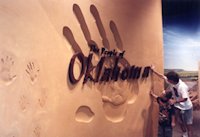 |
| Entrance to the Hall of the People of Oklahoma. Photo courtesy of OU's Sam Noble Museum. |
Society of Environmental Journalists 25th Anniversary and Dinner Party
6:30 - 11:00 p.m.
Board buses beginning at 6:15 p.m. outside the doors near registration. Shuttles will make continuous loops between the Embassy Suites and the Sam Noble Oklahoma Museum of Natural History, with the final shuttle leaving for the hotel at 11:00 p.m.
 Join us for an evening of music and dancing, cocktails and a full sit-down dinner, and celebrations with SEJ’s founding members at the Sam Noble Oklahoma Museum of Natural History. Curators will be on hand to lead small groups through exclusive behind-the-scenes tours, and we’ll have the full run of the exhibits, including the Hall of Ancient Life, the Hall of Natural Wonders and the Hall of the People of Oklahoma.
Join us for an evening of music and dancing, cocktails and a full sit-down dinner, and celebrations with SEJ’s founding members at the Sam Noble Oklahoma Museum of Natural History. Curators will be on hand to lead small groups through exclusive behind-the-scenes tours, and we’ll have the full run of the exhibits, including the Hall of Ancient Life, the Hall of Natural Wonders and the Hall of the People of Oklahoma.
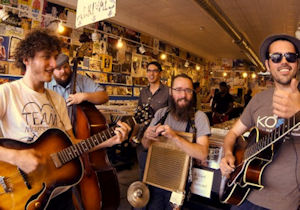 |
| Kyle Reid & The Low Swinging Chariots |
Our band, Kyle Reid & The Low Swinging Chariots, is hard to pigeonhole... a one-of-a-kind combo of New Orleans-style jazz and Western swing with some unique instruments. Take a peek for yourself: song samples one, two and three.
Pre-registration and $40 fee required.
Wednesday, October 7
Thursday, October 8
Friday, October 9
Sunday, October 11







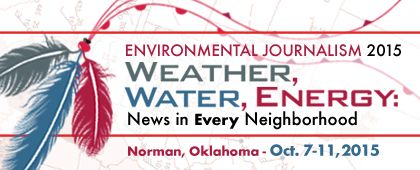




 Advertisement
Advertisement 



